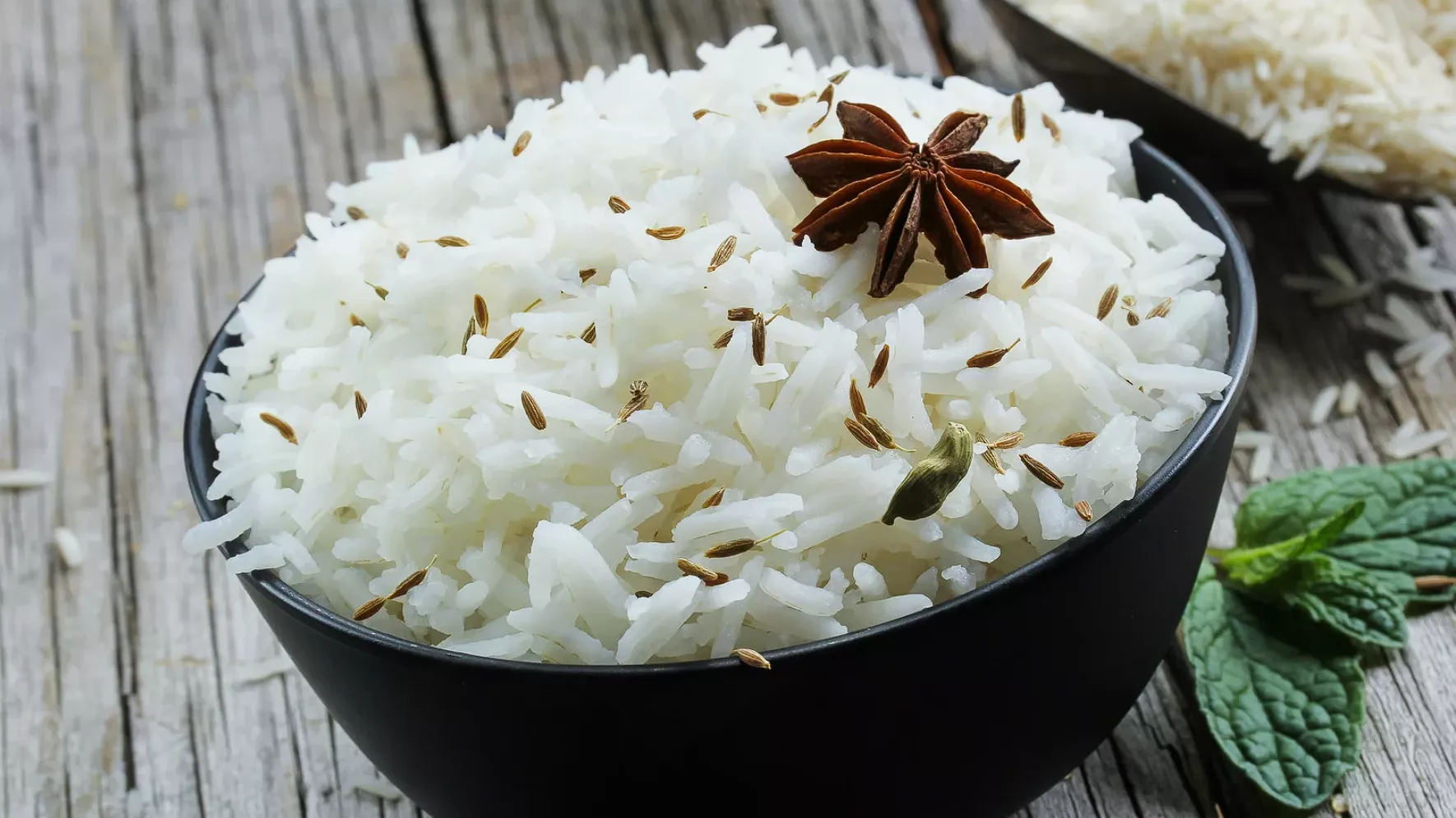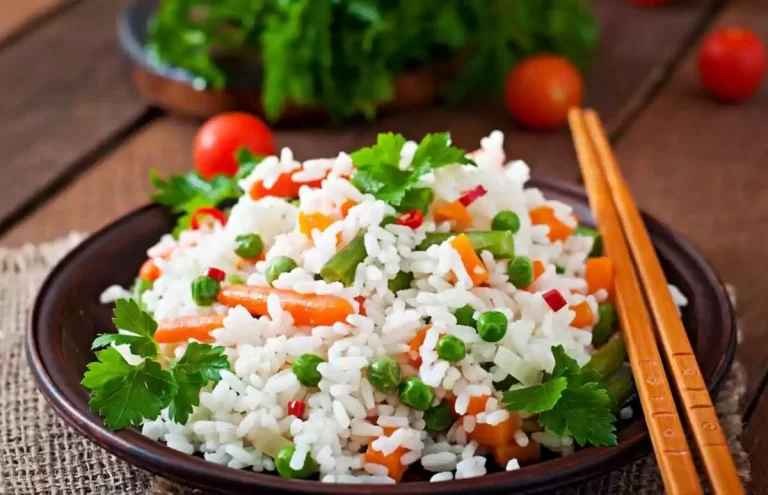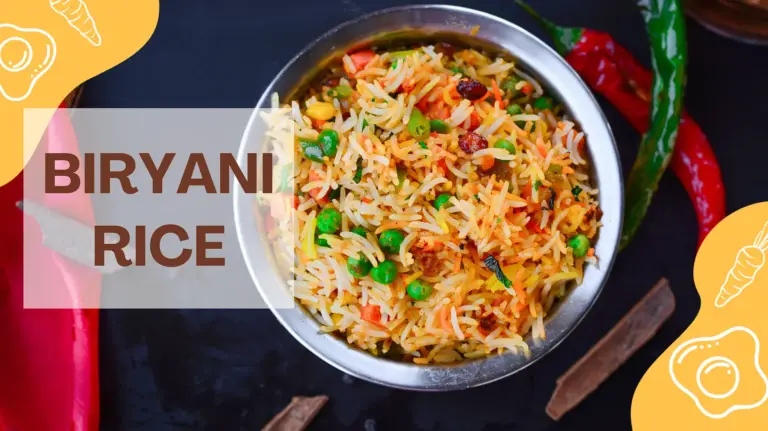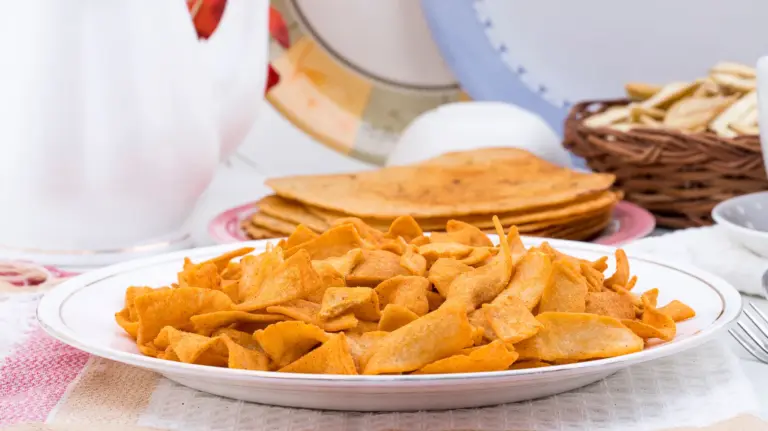Delicious Basmati Rice: A Culinary Journey into Fragrant Flavors

Introduction to Basmati Rice
Definition and origin of Basmati rice
Basmati rice, often hailed as the “king of rice,” is a long-grain rice variety known for its distinctive aroma and delicate texture. The word “Basmati” originates from the Hindi language, where “bas” means fragrance and “mati” means full of.
This name perfectly encapsulates the essence of this exquisite grain. The origin of Basmati rice can be traced back to the foothills of the Himalayan mountains in India and Pakistan.
Its cultivation can be dated as far back as 2,000 BCE, making it one of the oldest cultivated grains in the world. The unique geography and climate conditions in this region contribute to the exceptional characteristics that set Basmati apart from other types of rice.
Table of Contents
Significance and popularity of Basmati rice globally
Over time, Basmati rice has gained immense popularity worldwide due to its exceptional taste and quality. It has become a staple food not only in South Asian cuisine but also in various international dishes. The culinary world has embraced Basmati’s versatility, using it as a base for pilafs, biryanis, stir-fries, and even desserts.
Its ability to absorb flavors makes it an ideal choice for pairing with different ingredients and spices. From savory curries to fragrant side dishes, Basmati adds an unmistakable touch that elevates any meal.
Moreover, due to its long grains and fluffy texture when cooked properly, Basmati is often preferred over other types of rice for special occasions or celebratory feasts. Its presentation on a dining table can make any dish feel more luxurious.
In recent years, health-conscious individuals have also gravitated towards Basmati rice because it is low in fat content while being rich in essential nutrients such as carbohydrates, fiber, and B vitamins. It is also gluten-free, making it suitable for those with dietary restrictions or sensitivities.
The global demand for Basmati rice continues to rise steadily. Its export plays a significant role in the economies of India and Pakistan, where it is primarily cultivated.
The unique combination of aroma, texture, and taste has made Basmati a beloved grain across borders, bridging cultures and enticing taste buds around the world. In the following sections, we will delve deeper into the characteristics that make Basmati rice truly exceptional, explore its cultivation process, discuss different varieties available in the market today, and provide tips for cooking and storing this precious grain to ensure a delightful culinary experience.
Characteristics of Basmati Rice
Long-grain structure and delicate texture
Basmati rice, with its long and slender grains, stands out among other rice varieties. Each grain is thin and elongated, offering a visually appealing presentation on your plate. When cooked properly, the grains remain separate and don’t stick together in an unappetizing clump.
This quality makes Basmati rice ideal for dishes like biryani or pilaf where the grains need to retain their individuality. Its delicate texture adds a pleasant mouthfeel, making each bite enjoyable.
Distinctive aroma and flavor profile
One of the most remarkable qualities of Basmati rice is its captivating aroma that fills the kitchen as it cooks. The fragrance is often described as nutty or floral, with hints of jasmine or pandan leaves. This unique scent adds an enticing element to any dish prepared with Basmati rice.
Not only does it make your taste buds yearn for more, but it also elevates the overall dining experience. When it comes to taste, Basmati rice has a subtly sweet and nutty flavor that sets it apart from other types of rice.
The slight sweetness pairs well with savory dishes and allows the flavors to shine without overpowering them. Its natural nuttiness adds depth to every spoonful, making each bite satisfyingly delicious.
Superior nutritional composition compared to other rice varieties
Basmati rice not only delights your senses but also offers considerable health benefits. It contains higher levels of nutrients compared to other varieties of rice.
For instance, it is a rich source of complex carbohydrates that provide sustained energy throughout the day while being low in fat content. Moreover, Basmati rice contains essential minerals such as magnesium and potassium that support various bodily functions like muscle movement and heart health.
It also includes B vitamins, including thiamine and niacin, which are crucial for maintaining overall well-being. Furthermore, Basmati rice has a lower glycemic index compared to other rice types, making it a suitable choice for individuals aiming to regulate blood sugar levels.
Its lower glycemic index means that the carbohydrates are digested and absorbed slowly, preventing sudden spikes in blood sugar levels. Basmati rice’s long-grain structure, delicate texture, distinctive aroma, and sweet yet nutty flavor profile make it an exceptional choice for discerning palates.
Additionally, its superior nutritional composition sets it apart from other rice varieties and makes it a healthier option. Whether you’re preparing an aromatic curry or an exquisite pilaf dish, Basmati rice adds a touch of elegance to any meal while satisfying both your taste buds and nutritional needs
Ideal Growing Conditions for Basmati Rice Cultivation
Basmati rice is a temperate crop that thrives in specific environmental conditions. The ideal growing conditions include a warm climate with temperatures ranging between 20 to 30 degrees Celsius (68 to 86 degrees Fahrenheit). The region where Basmati rice is traditionally cultivated, such as the foothills of the Himalayas in India and Pakistan, provides these favorable conditions.
The availability of abundant water sources like rivers and irrigation systems is crucial for the success of Basmati rice cultivation. Additionally, Basmati rice requires well-drained soil with good fertility levels.
The soil should have a pH level between 5.0 and 8.5 to ensure optimal growth. Farmers often perform soil testing to assess its nutrient content and make necessary amendments before planting the crop.
Traditional Farming Methods vs Modern Techniques
Traditionally, Basmati rice was cultivated using age-old farming methods passed down through generations. These methods involved manual labor and close attention to detail.
Farmers would plow the fields using oxen or traditional hand tools, ensuring proper land preparation for planting. In contrast, modern techniques have introduced mechanization into Basmati rice cultivation.
Machinery such as seed drills, tractors, and harvesters are now commonly used by farmers who have access to advanced agricultural technology. While modern techniques enable higher efficiency in terms of time and labor savings, some traditional farmers continue to adhere to their tried-and-tested practices due to their deep-rooted cultural significance and belief in maintaining the authenticity of the crop.
Time-Sensitive Harvesting Process to Preserve Quality
The harvesting process plays a vital role in preserving the quality of Basmati rice. Timing is critical since harvesting too early or too late can significantly affect the aroma, taste, and texture of the grains. Basmati rice is typically harvested when the grains are fully matured but still retain a certain level of moisture.
Experienced farmers visually inspect the crop and perform manual checks to determine if the grains are ready for harvest. They look for specific indicators such as color changes, firmness of grains, and moisture content.
To ensure uniformity in grain maturity and quality, farmers often resort to manual harvesting methods where each panicle (flowering branch) is individually cut using sickles or knives. This meticulous process allows them to select only the ripest panicles while leaving behind those that need more time to mature.
Once harvested, Basmati rice undergoes further processing steps such as threshing, drying, cleaning, and polishing before it reaches consumers’ plates. Each step is carefully executed to maintain the unique characteristics that define Basmati rice.
Types and Varieties of Basmati Rice
Traditional Basmati: Classic long-grain variety with exceptional aroma
When it comes to Basmati rice, the traditional variety reigns supreme. Known for its long, slender grains and tantalizing aroma, traditional Basmati possesses a unique charm that sets it apart from other types.
The grains are delicate in texture, imparting a fluffy and light consistency when cooked to perfection. It’s no wonder why this variety has won the hearts of rice enthusiasts around the world.
One of the key features distinguishing traditional Basmati from other types is its distinct fragrance. The grains release a delicate floral and nutty scent when cooked, creating an enchanting sensory experience for anyone lucky enough to be in its presence.
This aroma is what gives traditional Basmati rice its signature allure and makes it a favorite choice for special occasions and gourmet dishes. Popular brands offering traditional Basmati rice include Kohinoor, Daawat, Tilda, and Lal Qilla.
These esteemed brands have perfected the art of preserving the authenticity of traditional Basmati rice through meticulous sourcing and processing techniques. Their commitment to quality ensures that consumers can enjoy an unparalleled culinary experience every time they cook with this prized grain.
Pusa Basmati: Hybrid variety developed for higher yield
In recent years, another variety known as Pusa Basmati has gained traction among farmers due to its higher yield potential compared to the traditional counterpart. Developed through hybridization techniques, Pusa Basmati offers advantages in terms of productivity while still retaining some cherished qualities of the classic variety.
One advantage of Pusa Basmati is its ability to produce significantly higher yields per acre compared to traditional Basmati varieties. This increased productivity makes it an attractive choice for farmers looking to optimize their harvests without compromising on quality too much.
Additionally, Pusa Basmati has a slightly shorter cooking time, which can be advantageous for those seeking efficiency in the kitchen. However, some purists argue that Pusa Basmati lacks the distinctive aroma and flavor of traditional Basmati.
While it still possesses a delicate fragrance, it may not match the intensity found in the classic variety. Nonetheless, Pusa Basmati offers a great alternative for those who want to strike a balance between yield and quality.
Organic/Non-GMO Basmati: Growing demand for healthier options
In today’s health-conscious world, there has been a surge in demand for organic and non-GMO products, including basmati rice. Organic/Non-GMO Basmati rice is cultivated without the use of synthetic pesticides or genetically modified organisms (GMOs), making it an appealing choice for those seeking healthier options on their plates.
Choosing organic or non-GMO varieties of basmati rice comes with several benefits. Firstly, these grains are free from harmful chemical residues that may be present in conventionally grown crops.
This translates to a cleaner and safer product on your plate. Secondly, organic farming practices promote environmental sustainability by maintaining soil health and biodiversity.
To ensure the authenticity and integrity of organic basmati rice, various certification standards have been put in place. Look for certifications such as USDA Organic or EU Organic to guarantee that the product meets rigorous organic farming criteria.
These certifications give consumers confidence in their choice while supporting sustainable agriculture practices. By opting for organic or non-GMO basmati rice, individuals can not only savor its exquisite taste but also contribute to their well-being and support sustainable agricultural practices all at once.
With such diverse options available within the realm of Basmati rice varieties – from traditional aromatic grains to higher-yielding hybrids and healthier organic choices – consumers now have ample scope to select one that perfectly suits their preferences and dietary requirements. Take the time to explore the nuances of each variety, experiment with different brands, and embark on a culinary journey that celebrates the rich heritage of Basmati rice.
Cooking Techniques for Perfectly Cooked Basmati Rice
Importance of Rinsing the Grains before Cooking
Subtitle: Unveiling the Secret to Flawless Fluffiness When it comes to preparing Basmati rice that is light, fluffy, and free from excess starch, one simple yet vital step often gets overlooked – rinsing the grains before cooking.
This seemingly insignificant act can make a world of difference in the texture and taste of your finished dish. By rinsing Basmati rice under cold running water, you effectively remove any dust, debris, or residual surface starch that may alter its delicate flavor and hinder its ability to achieve perfect fluffiness.
To rinse your Basmati rice properly, pour it into a fine-mesh sieve or colander and place it under cold running water. Gently swish the grains around with your fingers to ensure a thorough cleanse.
Continue rinsing until the water runs clear, indicating that most impurities have been removed. This simple step will guarantee that your cooked Basmati rice possesses an ethereal lightness that melts in your mouth with every bite.
Water-to-Rice Ratio and Cooking Time Guidelines
Subtitle: The Golden Ratio for Culinary Perfection Achieving perfectly cooked Basmati rice requires striking a harmonious balance between water and rice.
The ideal water-to-rice ratio depends on personal preference as well as the desired texture of the final dish. Generally speaking, a 1:1.5 ratio works well for fluffy long-grain Basmati rice.
To start, measure one cup of Basmati rice using a standard measuring cup (240 ml) and pour it into a saucepan or pot with a tight-fitting lid. Rinse the rice thoroughly as mentioned earlier, then drain any excess water from the pot.
Next, add one and a half cups of water to the pot. It’s important to note that different rice varieties may require slight adjustments to the water-to-rice ratio.
For example, if you prefer your Basmati rice slightly firmer or drier, you can reduce the water slightly. Conversely, if you prefer a softer or stickier texture, consider adding a bit more water.
Tips for Achieving Fluffy, Separate Grains
Subtitle: Unlocking Rice Mastery Cooking Basmati rice to perfection involves attention to detail and a few tricks of the trade.
Here are some valuable tips to help you achieve fluffy and separate grains every time: 1. Use a heavy-bottomed pot or saucepan with a tight-fitting lid.
This will ensure even heat distribution and prevent steam from escaping during cooking. 2. Once you’ve added the measured water to the rinsed rice in the pot, bring it to a gentle boil over medium heat.
Then reduce the heat to low and cover with the lid securely. 3. Resist the urge to peek!
Allowing steam to escape by lifting the lid during cooking can lead to unevenly cooked rice and compromised fluffiness. 4. Cook Basmati rice on low heat for approximately 15-20 minutes or until all liquid has been absorbed and the grains are tender yet firm.
Remember that cooking times may vary depending on factors such as altitude and stovetop efficiency. 5. After turning off the heat, let your perfectly cooked Basmati rice rest in its covered pot for an additional 5-10 minutes before fluffing it gently with a fork or chopsticks.
This resting period allows any remaining moisture in the pot to redistribute evenly throughout each grain, resulting in an extra level of fluffiness. By following these tips diligently and paying attention not only to measurements but also timing, you’ll achieve perfectly cooked Basmati rice that boasts a heavenly aroma, delicate texture, and separate fluffy grains that will elevate any dish to new culinary heights.
Special Considerations for Storing and Preserving Quality
A Proper storage containers to prevent moisture absorption
When it comes to storing Basmati rice, choosing the right container is crucial to maintain its quality. Opt for an airtight container that can keep moisture at bay. This will help prevent the rice from absorbing excess moisture, which can lead to clumping and spoilage.
Plastic or glass containers with tight-fitting lids work well in this regard. Avoid using paper bags or loosely sealed containers as they allow air and moisture to seep in, compromising the texture and flavor of your precious grains.
The impact of temperature, humidity, and
Temperature and humidity play critical roles in preserving the quality of Basmati rice. Store your rice in a cool, dry place away from direct sunlight and heat sources like stoves or ovens. High temperatures can accelerate the aging process of rice grains, causing them to lose their natural aroma and become less fluffy when cooked.
Moreover, exposing Basmati rice to excessive humidity can lead to mold growth or even insect infestation. It’s best to keep your storage area at a moderate temperature with low humidity levels.
Conclusion
Basmati rice is not just an ordinary grain; it is a true culinary treasure known for its delicate aroma, long-grain structure, and exceptional taste. By understanding the significance of proper storage techniques, you can ensure that this precious grain retains its freshness and quality for longer periods.
Consider investing in airtight containers that shield your Basmati rice from excess moisture absorption while keeping it protected from fluctuations in temperature and humidity. So go ahead, savor every cooking experience with Basmati rice as you embark on a gastronomic journey filled with aromatic delights!
Also See:
- Discover the Top 10 Healthiest Mushrooms for Optimal Wellness
- Discover the Best Low Sodium Snacks: Nourishing Delights
- Positive Relationships: The Art of Cultivating and Sustaining
- Discover the Secrets of Balanced Nutrition: Essential Tips for Optimal Health
- 10 Mouthwatering High Protein Vegan Snacks: Boost Your Energy
- Unlocking the Enigmatic Realm of Guitar Price: Harmony and Haggling
- Soya ChipsCrispy Delight: Soya Chips – A Healthy and Tasty Snack










